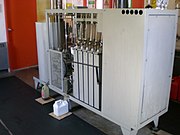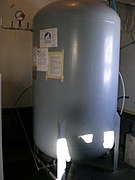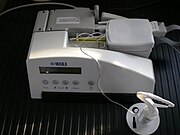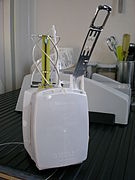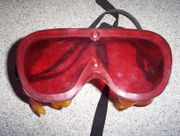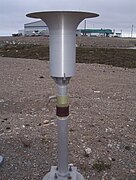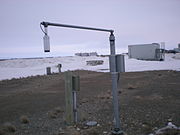User:CambridgeBayWeather/Weather
Appearance
Upper Air
[edit]-
Rear of the electrolyser.
-
Electrolyser front with electrical panel closest.
-
Electrolyser front with gauges and manometer closest.
-
Detail of the front of the cells on the electrolyser.
-
High pressure tank used to store hydrogen until needed.
-
Compressor pump in operation. Pumping and compressing hydrogen from the low pressure tank to the high pressure tank.
-
Low pressure tank into which the hydrogen is produced before being pumped into the high pressure tank.
-
Detail of electrical panel on the front of an electrolyser.
-
Detail of the gauges and manometer on the electrolyser.
-
Fyrite tester used to check the purity of the hydrogen. The oxygen content should read 0%.
-
Balloon fully inflated using 1,500 g (53 oz) lift.
-
800 g (28 oz) weather balloon, still in plastic wrap, and filling stand with 1,500 g (53 oz) lift.
-
Balloon laid out on table attached to filler stand.
-
Hydrogen filled balloon ready for launch. The radiosonde can be seen on the wooden stand.
-
Hydrogen filled balloon ready for launch. The radiosonde can be seen on the wooden stand.
-
A GPS radiosonde in the MW15 being prepared for use.
-
A GPS sonde ready for flight.
Weather instruments
[edit]-
Close up of regulator valve and pressure gauges as used to inflate ceiling balloons. The closer of the gauges shows the helium flowing to the balloon. The further gauge shows the amount of helium remaining in the tank.
-
Close up of the filler stand
-
A ceiling balloon cabinet. At the bottom can be seen the filler stand. The hose runs from the filler stand to the needle valve and then to the helium cylinder. On the left are stored more balloons, string and pibal lights.
-
A fully inflated ceiling balloon.
-
Exterior of a ceiling projector.
-
Interior shot of a ceiling projector. The bulb is just under the silver mirror at the top.
-
Alidade as used with a ceiling projector with a 300 m or 1000 ft baseline. The outer scale is in meters and the inner scale in feet.
-
Dark adaptor goggles are used at night prior to going outside to adapt the eyes to the dark.
-
A barograph of the type used by the Meteorological Service of Canada. This is a three day barograph.
-
Standard Ice Accretion Indicator (upside down).
-
Close up of a summer sunshine card for the Campbell-Stokes recorder. The amount of sunshine is recorded in 10th's of an hour.
-
Adapted Campbell–Stokes recorder for use in polar regions.
-
Aircraft altimeter set at 75 ft (23 m) showing a pressure of 29.87 in (1011.5 hPa). This altimeter is mounted in a console at a radio station.
-
The graduate for measuring the amount of melted snow.
-
The snow gauge funnel and mount. The container fits inside the funnel.
-
Copper catchment container for snow gauge.
-
Standard rain gauge. On the right can be seen a overflow catch with a metal pipe that fits over a metal post in the ground. On the left is the funnel with the graduated cylinder attached.
-
The interior of a tipping bucket rain gauge.
-
Exterior of a tipping bucket rain gauge.
-
View of the recorder and chart for a tipping bucket rain gauge as used in Canada. Each vertical line is a 10 minute period. Each horizontal line is 0.4 mm (0.02 in). The chart lasts for one day. The unit is powered by a clockwork motor
-
Close up of a chart used with a tipping bucket rain gauge. Each vertical line is 10 minutes and each horizontal line is 0.4 mm (0.02 in). Each upward step of the ink line is 0.2 mm (0.01 in).
-
The interior of a simple hygrometer. As the humidity rises the coil will expand.
-
Close up of the bulb of a maximum thermometer. The constriction in the tube and the break in the column of mercury can easily be seen.
-
A sling psychrometer, showing the "wet bulb" on top. The muslin sleeve, pictured here, is used at temperatures above −10 °C (14 °F) and when the temperature is colder then a thin layer of ice is formed on the bulb.
-
Interior of a Stevenson screen showing (from left to right) the dewcell, wet bulb with wick attached to water supply, dry bulb and dry thermistor. The metal pipe is called a psychrometer and sucks air across the thermometer
-
Exterior shot of a Stevenson screen. Visible at the top is the psychrometer motor.
-
Automatic weighing precipitation gauge
-
Snow depth sensor
-
An anemometer from the Young company.

